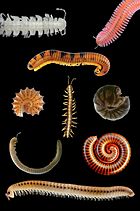Palaeosoma
| Palaeosoma Temporal range: | |
|---|---|

| |
| Palaeosoma giganteum fossil | |
| Scientific classification | |
| Kingdom: | |
| Phylum: | |
| Class: | |
| Superorder: | |
| Order: | †Palaeosomatida Hannibal & Krzeminski, 2005 |
| Family: | †Palaeosomatidae |
| Genus: | †Palaeosoma Jackson et al. 1919. |
| Type species | |
| Palaeosoma giganteum (Baldwin, 1911) | |
| Species | |
|
P. giganteum (Baldwin, 1911) | |
Palaeosoma is an extinct genus of archipolypodan millipedes from the upper Carboniferous of England and Poland. Individuals grew to nearly 20 cm (7.9 in) long and possessed defensive glands (ozopores) located on small raised nodes on the outer edges of the upper surface of each body segment. Species of Palaeosoma were once considered members of the family Euphoberiidae, which contains species with prominent spines, but are now classified in their own family (Paleosomatidae) and own order (Palaeosomatida), as they lack spines and have a combination of features not seen in other Paleozoic millipedes.[1][2][3][4]
References
- ^ Jackson, J. W.; H. K. Brade-Birks; S. G. Brade-Birks (1919). "Notes on Myriopoda. XIX. A revision of some fossil material from Sparth Bottoms, Lancs". The Geological Magazine. 6 (9): 406–411. Bibcode:1919GeoM....6..406J. doi:10.1017/S0016756800201659. S2CID 129754987.
- ^ Hannibal, J. (2005) A new occurrence of the millipede Palaeosoma (Archipolypoda) in the Carboniferous of Silesia, Poland, and its implications for the distribution of millipede genera in the tropics of Euroamerica during the Pennsylvanian. Geological Society of America Abstracts with Programs.
- ^ Hannibal, Joseph T.; Krzeminski, Wieslaw (2005). "A palaeosomatid millipede (Archipolypoda: Palaeosomatida) from the Carboniferous (Namurian A) of Silesia, Poland". Polskie Pismo Entomologiczne. 74 (3): 205–217.
- ^ Shear, William A.; Edgecombe, Gregory D. (2010). "The geological record and phylogeny of the Myriapoda". Arthropod Structure & Development. 39 (2–3): 174–190. Bibcode:2010ArtSD..39..174S. doi:10.1016/j.asd.2009.11.002. PMID 19944188.


